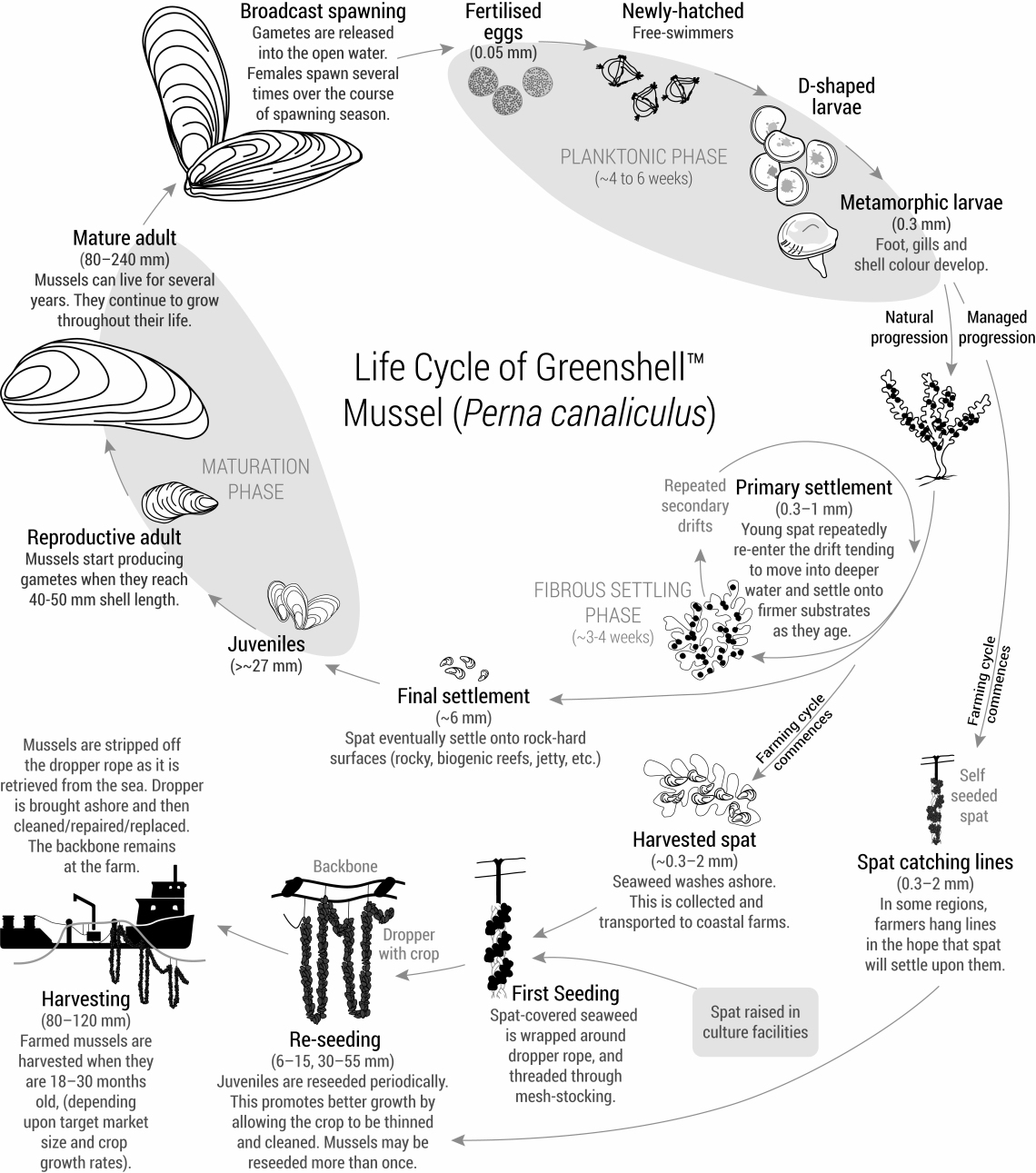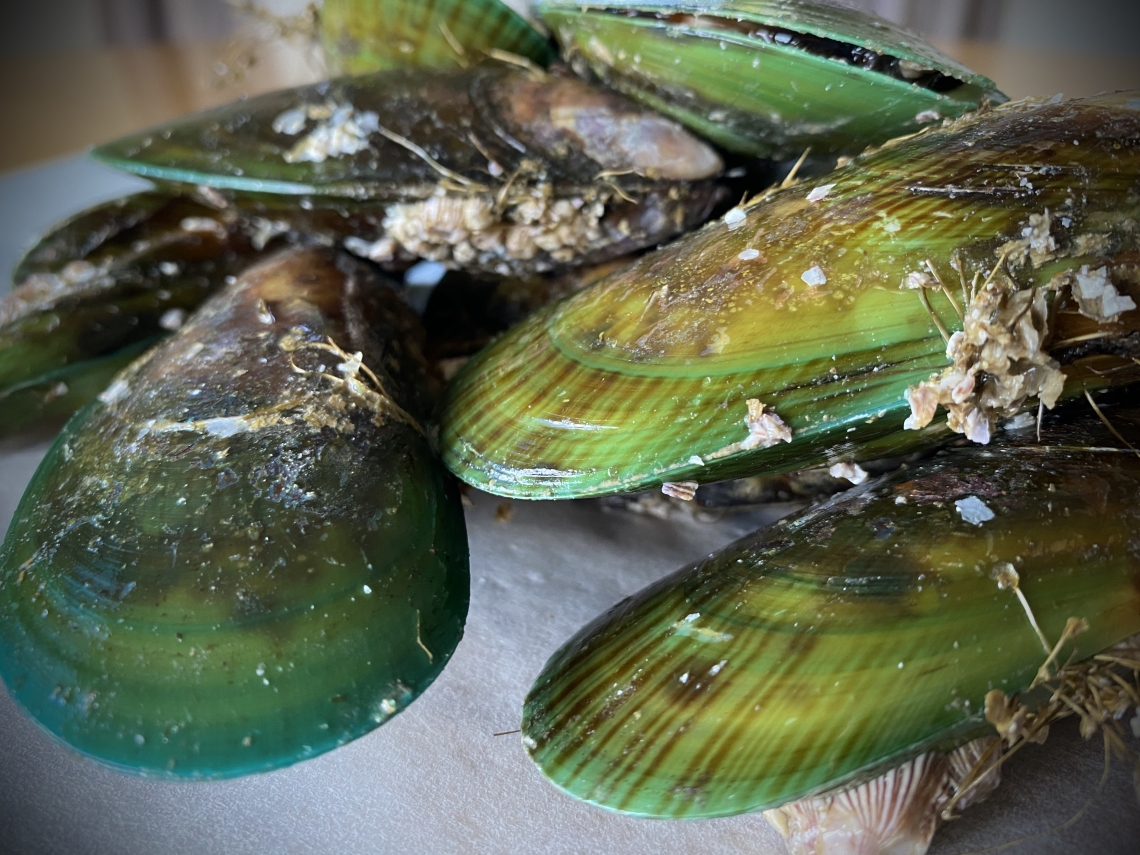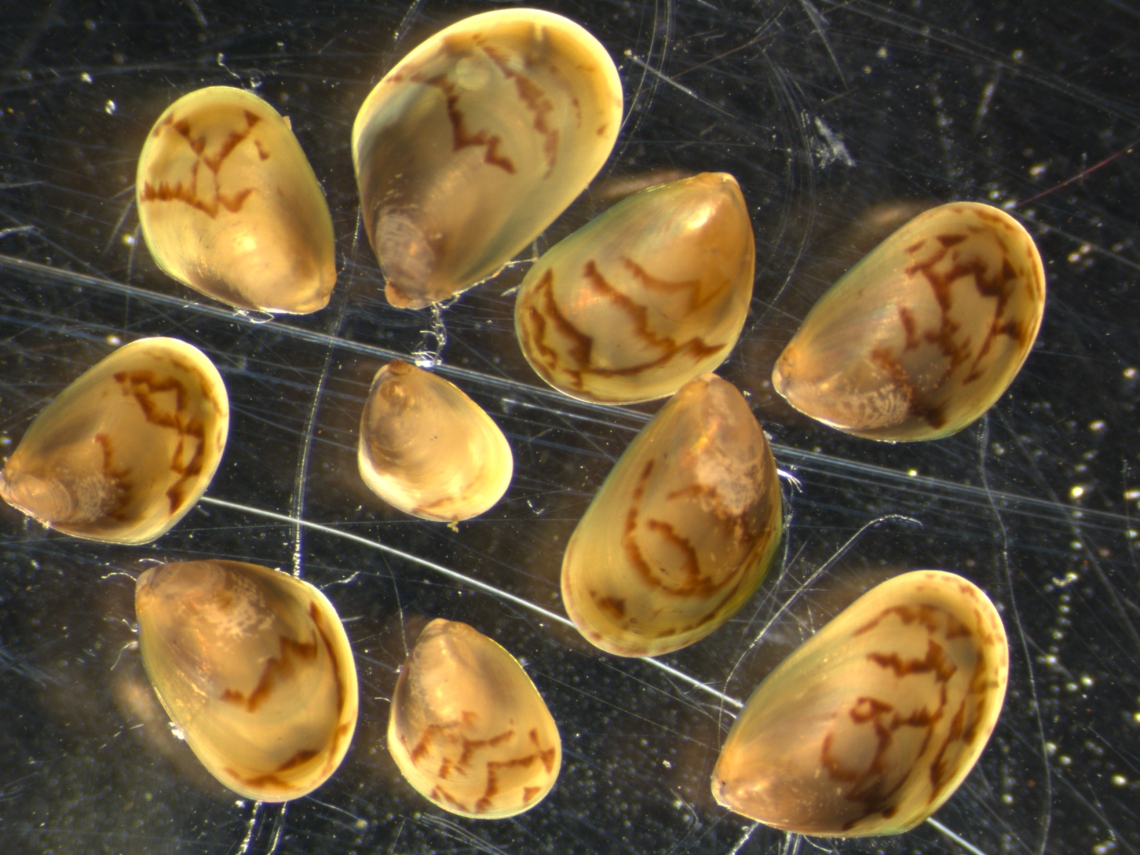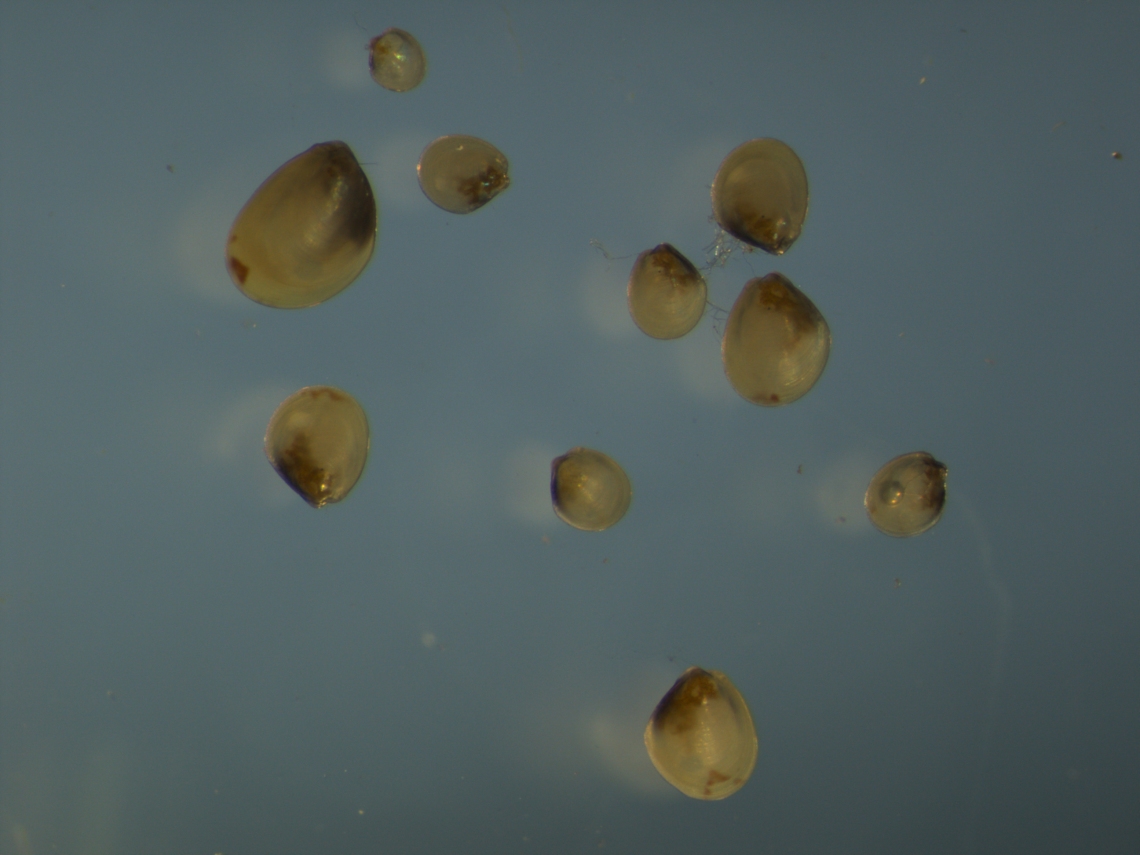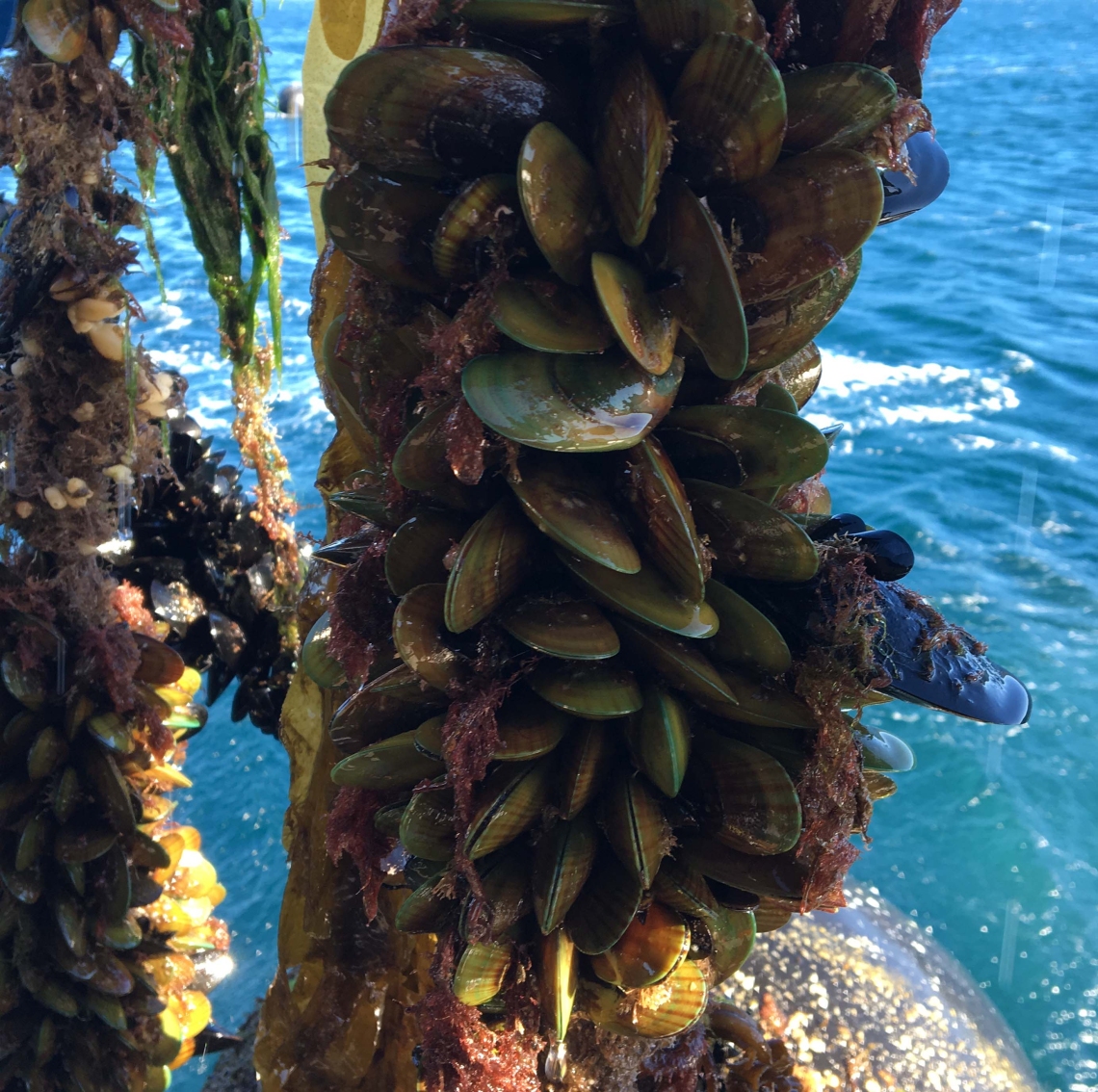About Greenshell™ mussel
Scientific name: Perna canaliculus
Māori names: kuku, kūtai
Greenshell™ mussel (also known as green-lipped mussel) are indigenous to New Zealand and have a moderately complex life-cycle.
In the wild, they can live for several years and grow to 20 cm or more (shell length) but most have become reproductively active by the time they reach 4-5 cm.
Adults release their gametes into the open water. Eggs, sperm and subsequent larval stages are planktonic. They will drift in the sea for approximately three to four weeks before becoming able to settle. Newly settled individuals (spat) are small (0.3 – 1 mm shell length).
Even after initial settlement, they remain capable of re-entering the drift until they reach approximately 6 mm shell length (approximately one month after initial settlement).
In the wild, Greenshell™ mussel tend to settle first on fibrous material (seaweed and seagrass etc) in shallow/inter-tidal water and subsequently actively re-enter the drift before ultimately settling on firmer substrates (rocky- and biogenic reefs, often in deeper water).
Why farm Greenshell™ mussel?
Shellfish are a nutritious food: high in trace elements, protein and poly-unsaturated fatty-acids, but low in cholesterol, saturated fats, and trans-fats. Shellfish production imposes a relatively small burden upon the local environment and the industry’s carbon and freshwater footprints are small in comparison with many other protein crops. Furthermore, unlike many modern farming systems, mussel farms support provide habitat which enables a diverse range of other species to thrive.
How are Greenshell™ mussel farmed?
Crop-mussels are grown on so-called long-line systems. Each long-line system is comprised of a taught ‘backbone’ strung across a line of surface floats and anchored to the seafloor at each end.
At the sea-surface, the backbone usually extends across about 110 m and carries ‘dropper ropes’.
The crop mussels are seeded onto the dropper, which is suspended from the backbone in a series of loops. Depending upon water-depth, each loop may extend to about 20 m. A backbone may carry approximately 2.5 – 3.5 km of dropper in total.
Whilst some spat are reared in dedicated culture facilities, the industry remains largely dependent upon wild-caught spat. Despite using dedicated spat-catching lines, the majority of the mussel crop stems from mussels grown from spat-encrusted seaweed which washes ashore along 90 Mile Beach (Te Oneroa a Tohe). The spat-encrusted seaweed (Te Hiku spat) is wrapped around the dropper and held in place using a degradable, mesh sock.
As the seaweed and sock degrade, the spat migrate onto the dropper and bind to it by secreting collagen fibres (byssus fibres, or ‘beard’). Several months later, the juvenile mussels are stripped from the dropper and the crop is thinned and reseeded. This thinning and reseeding might be repeated again later in the cycle.
Ultimately, mussels are usually harvested at around 8-10 cm shell-length (depending upon target market) – approximately 18-30 months after they were first seeded onto the crop-lines as spat (depending upon harvest size and growing conditions).
How is NIWA research helping sustainable Greenshell™ mussel aquaculture?
NIWA’s research aims to promote the continued development of an aquaculture industry that is both environmentally sustainable and economically successful. In the context of mussel farming, we are focussing on:
- Seeking to reduce crop-losses (particularly, the very high losses that farmers often suffer in the first three months after spat are first seeded onto lines)
- Improve our abilities to make seasonal-scale forecasts of crop-performance (annual yield, mussel condition and fatty acid content)
- Better predict how climate change will influence crop performance in future decades
- Better measure and forecast the influences which mussel farming have on coastal water quality and food web structure
Our research is designed in collaboration with the clients whom we serve: aquaculture industry, regional councils and central government agencies. For example, we are represented on the Marine Farmers Association Research & Development Committee, The Marlborough District Council Smart+Connected Aquaculture working group and the Open Ocean Farming working group.
Notable recent achievements include:
- Development of a novel camera system and spat-staining technique that will enable us to track the fate of marked cohorts of spat.
- Collaboration with the Australian Bureau of Meteorology to produce 6 month forecasts of likely future water temperatures.
- Rollout of a web-page that offers three-month, summer half-year forecasts of mussel condition for Pelorus Sound.
- A world-first interrogation of satellite data that showed that even a very large mussel farm (1200 ha) in the Firth of Thames is inducing only very small (<10%) depletion of surface-water phytoplankton standing stock and that this depletion does not extend far beyond the farm perimeter.
- Development of a novel, less intrusive means of estimating benthic exchange fluxes of oxygen etc, at larger spatial scales and longer time-spans than has been possible to date.
- Development of biophysical models of the Marlborough Sounds and, more recently, the Firth of Thames.
- Completion of a review of the ecosystem services of mussel farms that provides evidence which shows that mussel farms can have influences that many might consider to be beneficial.
References
- Alfaro, A.C., Jeffs, A.G., Gardner, J.P.A., Bollard Breen, B.A., Wilkin, J. (2011) Green-lipped Mussels in GLM 9. New Zealand Fisheries Assessment Report, 2011/48: 80. http://docs.niwa.co.nz/library/public/FAR2011-48.pdf
- Meyhoff-Fry, J. (2012) Carbon footprint of Scottish Suspended Mussels and Intertidal oysters, SARF078: 55.
- MPI (2013) Overview of ecological effects of aquaculture: 81. http://www.mpi.govt.nz/news-and-resources/consultations/marlborough-salmon-relocation/
- PFR, P.F.R., NZMOH, M.o.H. (2016) New Zealand food composition data. Plant and Food Research & The Ministry of Health. http://www.foodcomposition.co.nz
- Stenton-Dozey, J., Broekhuizen, N. (2019) Provision of ecological and ecosystem services by mussel farming in the Marlborough Sounds: A literature review in context of the state of the environment pre- and post-mussel farming (draft v2). National Institute of Water & Atmospheric Research Ltd, 2019020CH (project MFI19201): 145.
- van der Schatte Olivier, A., Jones, L., leVay, L., Christie, M., Wilson, J., Malham, S.K. (2018) A global review of the ecosystem services provided by bivalve aquaculture. Reviews in Aquaculture: 1-23. 10.1111/raq.12301
- Venugopal, V., Gopakumar, K. (2017) Shellfish: Nutritive Value, Health Benefits, and Consumer Safety. Comprehensive Reviews in Food Science and Food Safety, 16(6): 1219-1242. 10.1111/1541-4337.12312

